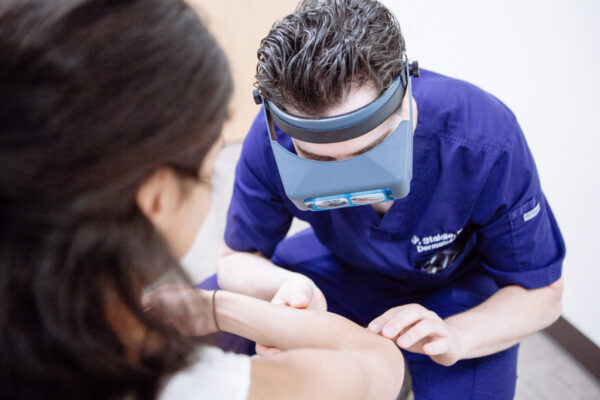Skin cancer occurs when skin cells start growing abnormally and cause cancerous growths. Most skin cancers develop on the visible outer layer of the skin (the epidermis), particularly in sun-exposed areas such as the face, head, hands, arms, and legs. It is usually easy to detect by examining the skin, and early detection increases the chances of early treatment and survival.
Almost all skin cancers start as small, low-risk lesions, but if left untreated, they can grow and become high-risk lesions.
Types of Skin Cancer
The three main types of skin cancer are basal cell carcinoma, squamous cell carcinoma, and melanoma. Melanoma is the most alarming type because it is more likely to invade surrounding tissues and spread to other parts of the body (metastasis) before being detected. Squamous cell and basal cell skin cancers are more likely to be detected and treated effectively before becoming malignant.
Diagnosing cancer typically requires a biopsy, in which a small piece of skin is removed for examination under a microscope and evaluated with other tests.
Skin Cancer Treatment
There are several different types of skin cancer, and in general, the treatment plan is based on the risk of the cancer spreading to other locations or growing again (recurring) in the same locations. Skin cancers that are likely to spread or recur are treated more aggressively.
Skin cancer treatment options may include medications such as Aldara (imiquimod) Cream or 5-fluorouracil. Procedures with higher cure rates include excision, electrodesiccation-curettage, and Mohs surgery.
Photodynamic therapy (PDT) is another treatment that is particularly effective for non-melanoma skin cancers. It is a minimally invasive treatment that uses a photosensitizing agent, which is a drug activated by light exposure, to destroy cancer cells. The process begins with the administration of the photosensitizer, either applied topically or injected into the bloodstream. After a period to allow the drug to accumulate in the cancer cells, the targeted area is exposed to a specific wavelength of light, typically from a laser or light source. This light activates the photosensitizer, causing it to produce a form of oxygen that kills the cancer cells. The American Cancer Society talks about it in more detail here.
Skin cancer prevention and treatment are top priorities at Dermatology Associates of Northeast Georgia, and our Double Board-Certified Dermatologist and Mohs Surgeon works closely with you to select a treatment method best suited for your specific case.










